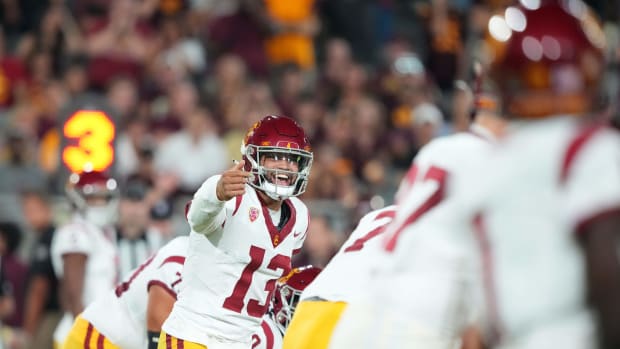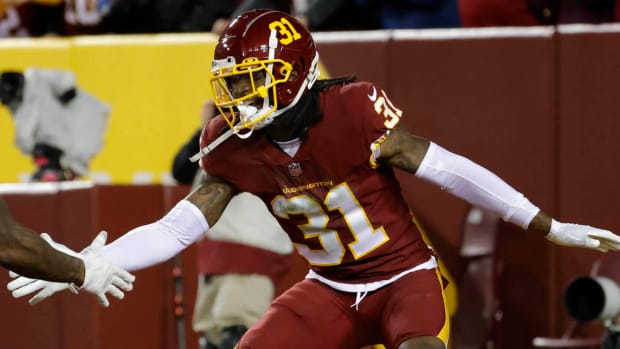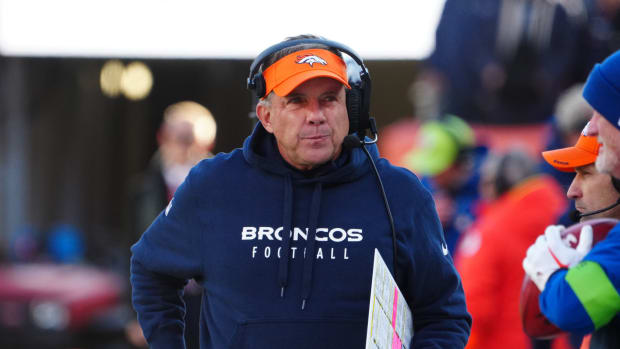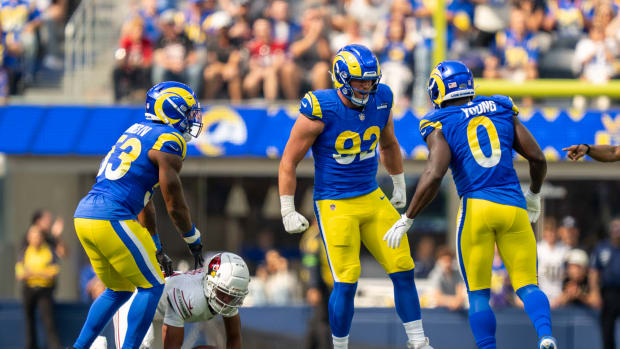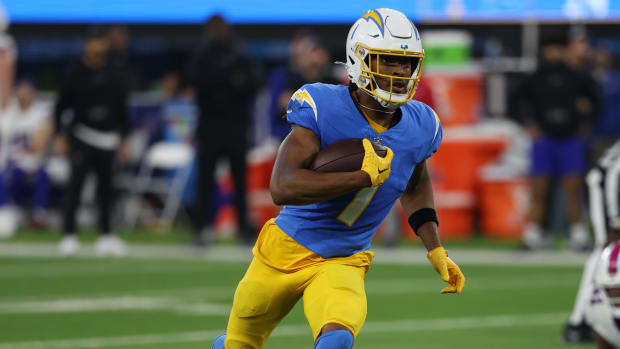Damar Hamlin: More Than a Moment in 2023
Damar Hamlin is on the phone from Buffalo after two weeks spent seesawing through every human emotion, each day simultaneously exactly what he wanted and not nearly enough. He’s discussing a video of himself a reporter put on X (the platform formerly known as Twitter) on Nov. 5, specifically, the text he wrote when he reposted it. It read, in part: y’all don’t know the half of it.
In the video, the Buffalo Bills safety walks onto the field at Paycor Stadium, alone, before the Bills’ Week 9 game against the Cincinnati Bengals. He stops near midfield. Kneels down. Appears to contemplate deeply. Snaps a selfie. And strolls off.
The video cannot show what he feels deep inside, he says. “What it truly takes to do what I’m doing. What it takes to truly, actually, return to something that actually kills you.”
Some people, Hamlin continues, touch a lit stove, realize how hot it is and never do it again. But he’s not just touching the NFL equivalent of a blistering stove; he’s placing his hand on there, intentionally, for months. “To return to something that actually stopped my heart and, you know, killed me, man . . . I [looked] death in the face. I faced death.”
Quick pause. “I made it through, by the grace of God.”
Hamlin survived, making the heart symbol, formed with two hands put together, his personal marker of resilience. But he does not want to be defined exclusively by what happened in January on that same field in Cincinnati. Instead, he trains his focus forward.
“To be able to still be who I was even before what happened, that’s the journey, the day in, day out of having to realize my reality of what happened to me—and still trying to chase this dream . . . to show strength through all the situations where we might not want to, where that might not be the first emotion that you want to express.
“It’s not easy at all,” he says. “It’s not even as easy as I thought it would be. It’s super tough. It’s extremely tough.”
[ Year in Review: From LeBron to Coco, see who made their mark in 2023 ]
Hamlin is being honest, not complaining or asking for sympathy. That’s not who he is. Instead he’s trying to help others, pushing for donations and awareness and change.
Damar Hamlin hasn’t changed, not even after Jan. 2.
Since 2018, John Bush Jr. has worked as a respiratory therapist on Paycor Stadium’s emergency action team. Through almost five full seasons, he had never needed to step onto the field. Not until Jan. 2, nine minutes into a game the Bengals led, 7–3, when Hamlin made a tackle and collapsed and his heart stopped beating.
Bush describes what happened next as “like a dream,” in which he saw himself from above, like watching an episode of Grey’s Anatomy in which he stars. His team and the Bills’ medical staff administered CPR and applied an automated external defibrillator (AED). After 19 minutes, they loaded Hamlin onto an ambulance. What happened would later be diagnosed as commotio cordis, when a blow to the chest makes the heart have an abnormal rhythm, leading to cardiac arrest.

When Hamlin went to tackle Cincinnati’s Tee Higgins in Week 17 last season, he never could have imagined all that would follow.
Kirk Irwin/Getty Images
Commissioner Roger Goodell would call Bush to thank him and the other first responders. But it was the on-field reactions that night that stood out. The players and coaches indicated endless respect and admiration for Hamlin. “They were calling out to him, encouraging him, telling him to stay strong,” Bush says. “Both sides. It just felt . . . different. Even looking at their faces: compassion, hurt, uncertainty. They were distraught. There’s no way they could have finished that game, because their hearts were with him.”
Bush stayed with Hamlin in the ambulance. He already considered Hamlin a member of the family. (Bush has one son and one daughter, both adults.) He leaned in and whispered, “I’m going to get you home to your mom.”
When Hamlin woke up the next day, about 16 hours after he collapsed, he wrote out three now-famous words that summarized the man who almost died and the mindset he carried forward: “Did we win?”
Bush, who came to visit Hamlin in the hospital, caught his gaze that afternoon. Neither said a word. Both tapped their chests with their fists, the same way.
“A miracle?” Bush sometimes wonders. “We saw him at his most vulnerable,” he says. Bush and the other first responders have had regular reunions with Hamlin since that night, including at the ESPYs, where Hamlin honored the first responders with the Pat Tillman Award for Service. They also saw him in November, when Buffalo returned to Cincinnati. “His smile was platinum,” Bush says. “It’s indescribable, just for him to be . . . alive.”
Long before his heart stopped, Damar Hamlin wanted to change the world. Friends, confidants and coaches all say so. Hamlin, now 25, grew up in McKees Rocks, Pa., a borough northwest of Pittsburgh. Known as The Rocks, it scores a 1 out of 100 on NeighborhoodScout’s “Total Crime Index”—meaning it’s safer than only 1% of U.S. neighborhoods. Hamlin’s mettle and his mindset were forged there, enhanced after a scholarship helped him enroll at Central Catholic, a private school. He idolized local hero Darrelle Revis and desired to create his own island. Determined never to be regarded as someone who wasted even a sliver of potential, he won state defensive player of the year his senior season.
Even then, Hamlin dreamt of wider impact—in The Rocks, in Pittsburgh, for kids growing up amid a landscape of examples he describes as “what not to do.” He wanted to become an inspiration, the kind he never had.
In 2016, he enrolled at Pittsburgh, a four-star recruit who passed on interest from powers like Ohio State and Penn State. By ’18, he was starting and the centerpiece of an elite defensive backfield. In his senior year, he was named a captain and made second-team All-ACC.
The Bills took Hamlin in the sixth round of the 2021 draft. He had already started a charitable foundation and become immersed in community service, working with and mentoring kids. His Chasing M’s Foundation, started in May ’20, is dedicated to health and safety and youth development, primarily through sports. In every summer except the one before his rookie season and during the pandemic, Hamlin has hosted free football camps for local teens around Pittsburgh.
His impact has only broadened over the past 11 frenetic months. Some of it was indirect, like the attention he generated toward AEDs, which skyrocketed in demand. Schools and youth organizations ordered them in such droves that there is now a shortage; the industry calls it “The Damar Effect.”
More directly, Chasing M’s held a CPR tour this past offseason in partnership with the American Heart Association, moving from Buffalo to Pittsburgh to Cincinnati to conduct free CPR training and provide no-cost AEDs to youth sports organizations in those cities. In March, Hamlin spoke at a Capitol Hill event introducing the Access to AEDs Act, filed in the U.S. House of Representatives. UC Medical Center in Cincinnati, where he was taken that January night, also expanded its training programs for CPR and AEDs.
And there was the toy drive GoFundMe he had started, which before that night in Cincinnati had some $3,000 in donations. Suddenly, there was more than $9 million, from more than 22,000 individuals, that he would use to support his charitable work.
Hamlin hosted another camp in Pittsburgh in July, stretching it over three days; this was bigger, broader, a spectacle worthy of sustaining the attention and momentum from that night. The city of Pittsburgh designated the final day, July 9, Damar Hamlin Day. As part of the event, Hamlin hosted CPR education clinics (this was when the tour hit Pittsburgh), held a charity softball game, a youth football camp and a high school football all-star game.
“I hope he’ll be known more for this work than football,” says Dr. B. Woods W. Curry, who treated Hamlin on the field at Paycor Stadium. “I’m not downplaying the work of football players. But this will be much more influential. It’s going to have an exponential ripple effect.”
Hamlin says his faith was never shaken. The Lord, he says, “hand-selected me for this. When everything tries to divide us—race, politics, differences—he chose me to bring the world together. He brought me through my situation, pulled me out of it, without nearly a scratch on me.
“I feel that energy, that I’m truly selected,” he says. “Who better than me for this mission than I’m on?
“I truly feel . . . no one.”
His goal, even as a teenager: to build a life worth living. Hamlin doesn’t believe what he’s carrying is heavy. In some ways, he says, it’s enviable, this position.
He was active for only two of the Bills’ first 11 games this season. Make no mistake: He wants to play more. But wanting to play more and tying his broader happiness to snap counts—44 through Week 11 this season, mostly on special teams, with only nine on defense—are not the same thing.
Chasing M’s started as a clothing brand he established during his Pitt days. The name summarized the ambition. Chasing Millions. But priorities change. Hamlin’s life is bigger than chasing millions now. With football, he says, simply, that he wanted to return to end his career on his terms. “I just wanted to show myself that I could do it.”
He says his calling has always gone beyond the field. “It’s important to highlight that this is a space I always saw myself getting, one way or another,” he says. He always thought he’d be able to provide inspiration. “I just saw it [before] through the game of football,” he says. “But I promise you, I was gonna get there.”
Bush, the respiratory therapist who helped save Hamlin’s life, knew the Bills would return to Cincinnati this season, but not that Hamlin would extend a dinner invitation to the first responders and medical staff who saved him. Bush showed up early to Jeff Ruby’s Steakhouse and stopped by the bar, where he bumped into Mario Hamlin, Damar’s father.
“Can you bless the food before we eat?” Mario asked.
The dinner was set up in a private space, and Hamlin traversed the room, intent on speaking to each of the responders, thanking them and catching up. Bush never saw him break eye contact with who he was speaking to, ensuring that each person felt important.
Food flowed, juicy steaks and all the sides. But before anyone put fork to plate, Bush stood before the group and spoke from his heart. He gave thanks for the dinner, that moment they were all now sharing—for perilous experiences that, if channeled properly, can lead to ever-widening impact.
More than anything, though, Bush thanked Hamlin. Nobody would have blamed Hamlin if he had retreated from the spotlight. Instead, Hamlin embraced the attention heaped upon him, but used it only in ways to help others. Wow, Bush thought, what healthy perspective.

A week after feting his saviors at a dinner in Cincinnati, Hamlin made a tackle against the Broncos.
Courtesy of Damar Hamlin
That night, Hamlin surprised the 10 attendees with scholarships in their names to benefit local youth. They were $1,000 each for students from underserved communities to put toward private area high schools or colleges. This, Hamlin calls his “extra level of thank you.”
Hamlin told Bush that night, “I remember you said you would breathe for me the whole time.”
“Yeah,” Bush responded, “and I said I was gonna get you to your mom.”
Hamlin smiled. “Oh, man,” he said. “You just gave me chills.”
The next night, Hamlin walked into Paycor Stadium for another NFL game. He knew he wouldn’t be playing. He didn’t force any sort of rousing speech. He simply said to individual teammates, “Go win.”
Before kickoff, Hamlin smiled and dapped and embraced. He wore custom cleats onto the same field where he nearly died not even a year earlier. They read 3 is back across the heels.
Curry, the doctor, watched that moment unspool. “Some people take these opportunities to look inward,” he says. “I’m sure he has done that. And some people will take the opportunity. He’s using a platform [from] a really traumatic incident to help save other people. There’s a word for that. Inspirational is the term for it.”
Hamlin met the family of a teenage football player from New Jersey recently. The boy had dropped to the turf, just like he did. But there was not an AED nearby, and the boy died. Hamlin brought the boy’s family to Pittsburgh for that camp weekend in July. “Just to show them some love,” he says. “All these new eyes on me, it just took the same vision I had and made it global. I want an everlasting legacy, an everlasting impact.”
The NFL moved on, moved forward, after Hamlin’s injury. Always does. Hamlin understands this. Over these recent weeks, throughout the first half of this season, Hamlin leaned into having a healthy perspective more than ever. Every emotion fought for more prominent placement in his brain, frustration and anxiety and fear and inspiration and determination and resolve existing in the same place, at the same time. Hamlin knew he had enough. He also knew he wanted more.



































